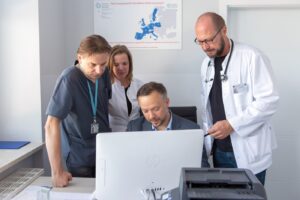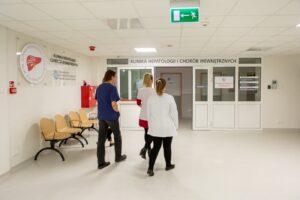European Reference Networks are based on the idea of joining forces across borders to improve the clinical care of persons with rare diseases. For patients, it means a professional and faster diagnosis. For doctors – an opportunity to acquire knowledge and refine treatment modalities.
ONE OF the most serious problems experienced by people suffering from rare diseases is to receive a diagnosis. ‘A disease is considered to be rare if it affects fewer than one person in 2000. We cannot expect a general practitioner or even a specialist at a hospital to know the symptoms of such diseases considering that statistically, they have a chance to encounter a patient of that type once every 15–20 years. That said, the sooner the patient is diagnosed, the more effective the treatment is,’ explains Professor Piotr Milkiewicz, member of the board of the European Reference Network ERN RARE-LIVER, whose objective it is to help patients with rare hepatological diseases.
Platform for Conducting Research
The Liver and Internal Medicine Unit of the Medical University of Warsaw led by Prof. Milkiewicz is one of 28 centres in Europe that are members of ERN RARE-LIVER. Other full members are units located in Belgium, Denmark, France, Germany, Italy, the Netherlands, Portugal, Spain, Sweden and the UK. Moreover, the network has four affiliated partners and thirteen collaborative partners.
‘The patients who are referred to us fairly often have atypical clinical symptoms and abnormal liver blood tests or imaging studies that could be challenging to interpret. It is definitely an advantage for patients, who can count on specialist diagnostics and the possibility to consult the best experts in Europe, because the cooperation within the network entails the possibility of consultations online,’ Prof. Milkiewicz says. ‘We can share test results and ask colleagues from other centres for their opinion, e.g. when interpreting the results of a liver biopsy, which is sometimes a very difficult task.
In addition, the network constitutes a huge platform for research. While one unit can present its experience with a couple of dozen patients, together we can analyse and publish results of, for example, one thousand patients,’ Prof. Milkiewicz explains.
Dr. Marcin Krawczyk, a hepatologist from Saarland University Medical Center in Homburg, Germany, emphasises that today it is difficult to carry out research without cooperating with other institutions, including foreign ones. The pace of scientific progress forces research units to specialise. Cooperation enables scientists to make use of the greatest strengths of each research project participant. ‘I work in Poland and in Germany. When Prof. Milkiewicz and I were writing a publication on rare chronic liver disease, in this case primary sclerosing cholangitis (PSC), we analysed the molecular and biochemical aspects in Germany, while the diagnostic and therapeutic evaluations were carried out in Poland,’ says Dr. Krawczyk.
Scientific Project to Improve the Quality of Patients’ Lives
In addition, various research projects are carried out at ERN RARE-LIVER in collaboration with patient organisations. Their objective is to improve the quality of life of patients suffering from rare diseases. The concept is to alleviate the bothersome and sometimes devastating symptoms of the diseases themselves, but also side effects of the treatment. One example could be therapy with steroid drugs, which is used to treat autoimmune hepatitis. The drug eliminates the symptoms of the disease, but also alters the patients’ appearance. It may, for example, cause uneven deposits of fat tissue , e.g. on the back of the neck and on the face, producing the effect of the so-called moon face.
‘Autoimmune hepatitis often affects young women. Problems with their appearance quite often cause depression. Patients with depression, in turn, cease to take medication, and so we have a vicious circle,’ Prof. Milkiewicz explains.
There are 24 reference networks in total in the European Union, each specialising in diagnosing a different group of diseases. They include 900 specialist health care units from more than 300 hospitals in 26 EU member states.
Medical University of Warsaw
Liver and Internal Medicine Unit
Read more: „Science in Poland in 34 Snapshots”





